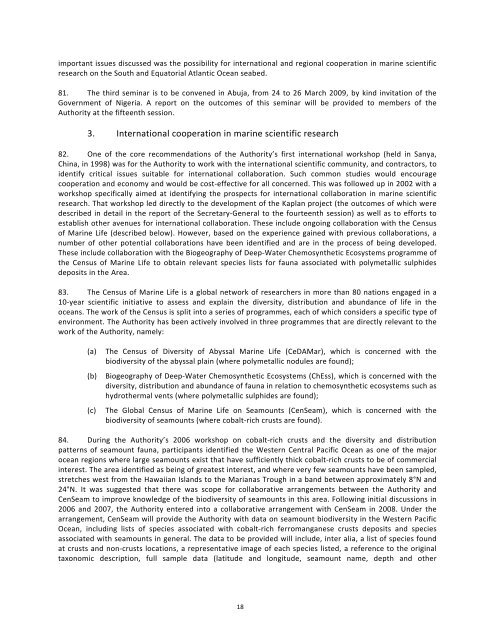Selected Decisions and Documents - International Seabed Authority
Selected Decisions and Documents - International Seabed Authority
Selected Decisions and Documents - International Seabed Authority
You also want an ePaper? Increase the reach of your titles
YUMPU automatically turns print PDFs into web optimized ePapers that Google loves.
important issues discussed was the possibility for international <strong>and</strong> regional cooperation in marine scientific<br />
research on the South <strong>and</strong> Equatorial Atlantic Ocean seabed.<br />
81. The third seminar is to be convened in Abuja, from 24 to 26 March 2009, by kind invitation of the<br />
Government of Nigeria. A report on the outcomes of this seminar will be provided to members of the<br />
<strong>Authority</strong> at the fifteenth session.<br />
3. <strong>International</strong> cooperation in marine scientific research<br />
82. One of the core recommendations of the <strong>Authority</strong>’s first international workshop (held in Sanya,<br />
China, in 1998) was for the <strong>Authority</strong> to work with the international scientific community, <strong>and</strong> contractors, to<br />
identify critical issues suitable for international collaboration. Such common studies would encourage<br />
cooperation <strong>and</strong> economy <strong>and</strong> would be cost‐effective for all concerned. This was followed up in 2002 with a<br />
workshop specifically aimed at identifying the prospects for international collaboration in marine scientific<br />
research. That workshop led directly to the development of the Kaplan project (the outcomes of which were<br />
described in detail in the report of the Secretary‐General to the fourteenth session) as well as to efforts to<br />
establish other avenues for international collaboration. These include ongoing collaboration with the Census<br />
of Marine Life (described below). However, based on the experience gained with previous collaborations, a<br />
number of other potential collaborations have been identified <strong>and</strong> are in the process of being developed.<br />
These include collaboration with the Biogeography of Deep‐Water Chemosynthetic Ecosystems programme of<br />
the Census of Marine Life to obtain relevant species lists for fauna associated with polymetallic sulphides<br />
deposits in the Area.<br />
83. The Census of Marine Life is a global network of researchers in more than 80 nations engaged in a<br />
10‐year scientific initiative to assess <strong>and</strong> explain the diversity, distribution <strong>and</strong> abundance of life in the<br />
oceans. The work of the Census is split into a series of programmes, each of which considers a specific type of<br />
environment. The <strong>Authority</strong> has been actively involved in three programmes that are directly relevant to the<br />
work of the <strong>Authority</strong>, namely:<br />
(a)<br />
(b)<br />
(c)<br />
The Census of Diversity of Abyssal Marine Life (CeDAMar), which is concerned with the<br />
biodiversity of the abyssal plain (where polymetallic nodules are found);<br />
Biogeography of Deep‐Water Chemosynthetic Ecosystems (ChEss), which is concerned with the<br />
diversity, distribution <strong>and</strong> abundance of fauna in relation to chemosynthetic ecosystems such as<br />
hydrothermal vents (where polymetallic sulphides are found);<br />
The Global Census of Marine Life on Seamounts (CenSeam), which is concerned with the<br />
biodiversity of seamounts (where cobalt‐rich crusts are found).<br />
84. During the <strong>Authority</strong>’s 2006 workshop on cobalt‐rich crusts <strong>and</strong> the diversity <strong>and</strong> distribution<br />
patterns of seamount fauna, participants identified the Western Central Pacific Ocean as one of the major<br />
ocean regions where large seamounts exist that have sufficiently thick cobalt‐rich crusts to be of commercial<br />
interest. The area identified as being of greatest interest, <strong>and</strong> where very few seamounts have been sampled,<br />
stretches west from the Hawaiian Isl<strong>and</strong>s to the Marianas Trough in a b<strong>and</strong> between approximately 8°N <strong>and</strong><br />
24°N. It was suggested that there was scope for collaborative arrangements between the <strong>Authority</strong> <strong>and</strong><br />
CenSeam to improve knowledge of the biodiversity of seamounts in this area. Following initial discussions in<br />
2006 <strong>and</strong> 2007, the <strong>Authority</strong> entered into a collaborative arrangement with CenSeam in 2008. Under the<br />
arrangement, CenSeam will provide the <strong>Authority</strong> with data on seamount biodiversity in the Western Pacific<br />
Ocean, including lists of species associated with cobalt‐rich ferromanganese crusts deposits <strong>and</strong> species<br />
associated with seamounts in general. The data to be provided will include, inter alia, a list of species found<br />
at crusts <strong>and</strong> non‐crusts locations, a representative image of each species listed, a reference to the original<br />
taxonomic description, full sample data (latitude <strong>and</strong> longitude, seamount name, depth <strong>and</strong> other<br />
18
















